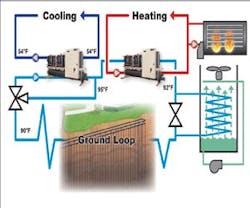If you’re considering a geoexchange system but aren’t sure if the performance will be reliable enough, consider hybridizing your system. You can pair your loop field with a backup system, such as a boiler, chiller, cooling tower, underfloor air distribution, or ice storage.
“A lot of owners hybridize for peace of mind because it’s not always preferable to put all of your eggs in one basket,” says Rick Hermans, director of training and advanced applications for McQuay International, a manufacturer of HVAC equipment. “An added boiler or cooling tower gives an owner the assurance that the load will always be met.”
This strategy is ideal for existing buildings, properties constricted by available land, and facilities that anticipate expansion.
Strategies for Hybridization
Regardless of which option you choose, the output of the geoexchange isn’t affected – it’s simply augmented by an added system.
“When a building is located in a climate that doesn’t have a balanced heating and cooling load, a designer will go with a hybrid geoexchange system and size the well field to the smaller of the two loads,” says Hermans.
The system is sized for the cooling portion in northern states and balanced for heating in southern regions. No longer will you have to worry about whether the geoexchange can fully supply your load requirements during seasonal extremes.
You can also hybridize with a dedicated outdoor air system that includes an energy recovery wheel, suggests Marc Sorge, a product sales manager for Greenheck Fan Corporation, a supplier of HVAC solutions.
The energy recovery wheel transfers the energy exhausted from the building to the supply air stream. By pre-tempering the air, it reduces the load of the geoexchange loop, boiler, or cooling tower.
“Let’s say your winter design temperature is -18 degrees F. and you want to bring air into the building at 73 degrees. You can pre-temper the outside air that’s -18 degrees to 40 or 50 degrees and save a substantial amount of heating energy,” says Sorge. “Similar savings apply in the summer when the energy recovery wheel pre-cools and dehumidifies the outdoor air prior to the cooling coil.”
Drawbacks
While a hybrid option sounds like the best of both worlds, it’s not always the right choice. Remember that geoexchange isn’t 100% clean energy – a minimal amount of energy is required to operate pumps and fans, as well as your supplemental system.
“There is a slight energy penalty for a hybrid system as opposed to a straight geoexchange one,” warns Hermans.
You also need to address fresh air requirements, usually with a dedicated outdoor system. To transfer energy between the exhaust and supply air streams, the streams must be in close proximity and supported by appropriate ductwork. Once connected, they can be operated with a single control.
However, this option may not be appropriate if your location isn’t in a clean air environment. Because energy is transferred between two air streams, there is a small amount of cross- leakage that can negatively impact IAQ and even life safety, Sorge explains.
Benefits Abound
There are a number of ways a hybridized system makes sound financial sense. You can scale back each portion of the system because the load is divided between both halves.
This lowers drilling, piping, and equipment costs, shaving off approximately 8% of your initial costs, Hermans estimates.
Don’t forget about rebates or tax incentives that could apply to either your loop field or the added HVAC component.
With energy recovery, you can reduce your mechanical heating and cooling requirements by 30-50%, specifies Sorge. Payback is generally between six months and four years, with the highest payback in extreme climates.
A hybrid geoexchange system also affords you a level of flexibility that a traditional system can’t. Loop fields are difficult and costly to expand later on if the system isn’t meeting your load requirements.
By hybridizing or simply leaving space for supplementary components, your system can easily adapt to building changes.
Jennie Morton ([email protected]) is an associate editor of BUILDINGS.
About the Author
Jennie Morton
A former BUILDINGS editor, Jennie Morton is a freelance writer specializing in commercial architecture, IoT and proptech.
